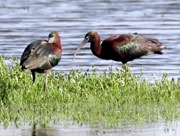3. Irving Nature Park
Sand Cove Road, West Saint John

One of Canada’s Important Bird Areas right in the city! This is Saints Rest Marsh. The Important Bird Areas Program (IBA) is a science-based initiative aimed at identifying, conserving and monitoring a network of sites that provide essential habitat for Canada’s bird populations. On the tidal marsh, on the open mudflats, on the barrier beach or in the coastal spruce forest of the Irving Nature Park, you will be entertained by a myriad of birdlife that can only be attributed to the richness and diversity of the Bay of Fundy. This site received its world recognized ‘IBA’ designation because of the globally significant numbers of Semipalmated Sandpipers and Semipalmated Plovers that stop here during their autumn migration. To these birds autumn occurs anytime between late July and late October. The sandpipers and plovers congregate here because of the expansive mudflats that teem with marine worms and small shrimp-like organisms known as amphipods. They fattened up on this natural source of protein in preparation for their long migration to South America for the winter. While the birds are here for about one month they entertain thousands of school children, visitors, and birding enthusiasts. Saints Rests’ coastal location and habitat diversity is also the main reason why the site also attracts such a large number of uncommon species too.
The hopefuls still come to the Marsh to catch a rare look at the Glossy Ibis, a southern species that attempted to nest here in the early 1990’s. This site’s uniqueness delivers memorable moments with frequency and variety. Saints Rest might offer you a minute crunched into an instant as you watch a Peregrine Falcon buzz the shorebirds, or a Northern Harrier leisurely working the marsh only to drop like a stone onto an unsuspecting Nelson’s Sharp-tailed Sparrow. Things are always happening here. When the tide is out Greater Yellowlegs will be displaying and calling their high pitched notes, happily giving up the whereabouts of their feeding place as they probe the shallows and mudflats in search of lunch. Over the cordgrass in the marsh weave tight-knit family groups of Blue-winged Teal. Their flight resembling that of shorebirds, but their chunkier size and light brown and buff bellies, as well as their chalk-blue shoulder patch are the telltale signs of the earliest migrant of the family Anatidae. The handsome Cliff Swallows are also residents here. These colonial nesters can be seen making never-ending return trips carrying food to their young in the most altruistic display of nature.
But this wildlife jewel existed in another form not too long ago. The Marsh has had a history as a working salt marsh, contributing to the local agrarian economy. The marsh was dyked in the late 1700’s and used until the turn of the 20th century for pasture and hay production. Icons of agricultural and progress, the barns that once dotted the marsh landscape have disappeared, and after a long period of abandonment the dyke was breached sometime in the 1950’s. Since then the Bay of Fundy has slowly but surely reclaimed its next of kin. Progress is a relative term and its present expression is in the ideas, philosophies, and behaviours of people founded on environmental sustainability. Conservation and education efforts of the Irving Nature Park have exposed thousands of young people and the general public to the values of wild spaces. The emotions produced by nature that are internalized by people shape our beliefs and behaviours and culminate in an appreciation and understanding of the role of those natural habitats that surround us. Conservation groups like the Nature Trust of New Brunswick, who has secured portions of Saints Rest Marsh for people to enjoy in perpetuity, play an important ole as advocates for natural areas. All of these efforts have formalized the recognition that the marsh so rightfully deserves. It seems that like the endless energy of the tides this site has inspired many to take up the cause of natural resource stewardship.
Take a walk along the forest trails for an intimate look at this jewel of a headland island that is connected to the mainland by the narrow strip of beach. More than 250 species of birds have come through the marsh and forest during migration periods. The forest is a good example of an Acadian forest with representative species such as Red Spruce, Balsam Fir, and Yellow Birch. Take the Frog Trail at the tip of the island and walk out onto a sphagnum moss bog. In total eight walking trails allow unfettered exploration of this unique site. You will need to find the spectacular observation tower hidden among the treetops at the highest point of the island, which offers breathtaking views of this coastal area. During your exploration of the park you will no doubt run in to Red-eyed Vireos, Magnolia Warblers, American Redstarts, Common Yellowthroats, and Alder Flycatchers.
In addition, a 300 meter long boardwalk will take you out to the salt marsh and mudflats for a close-up look at life in tidal conditions. The Sandpipers will entertain you as they probe the mudflats with a busyness that is truly delightful.